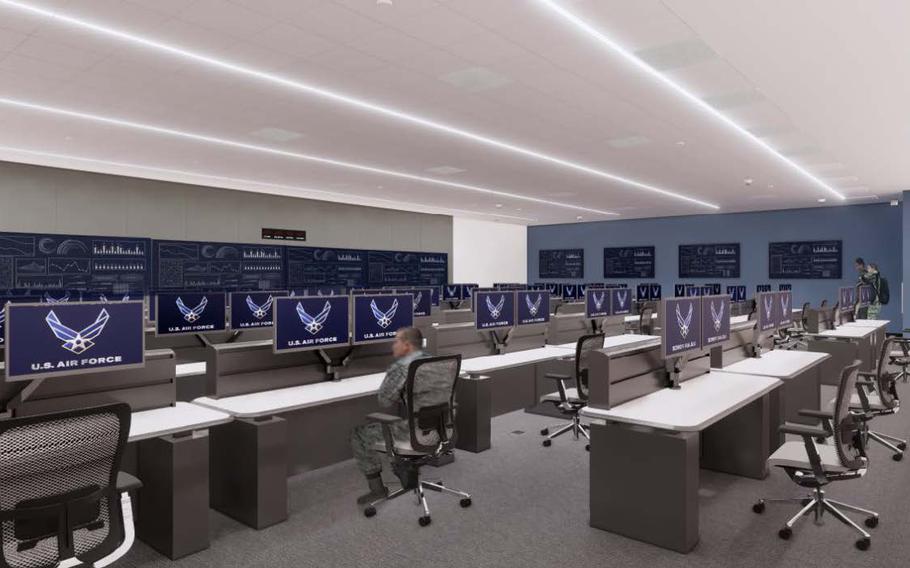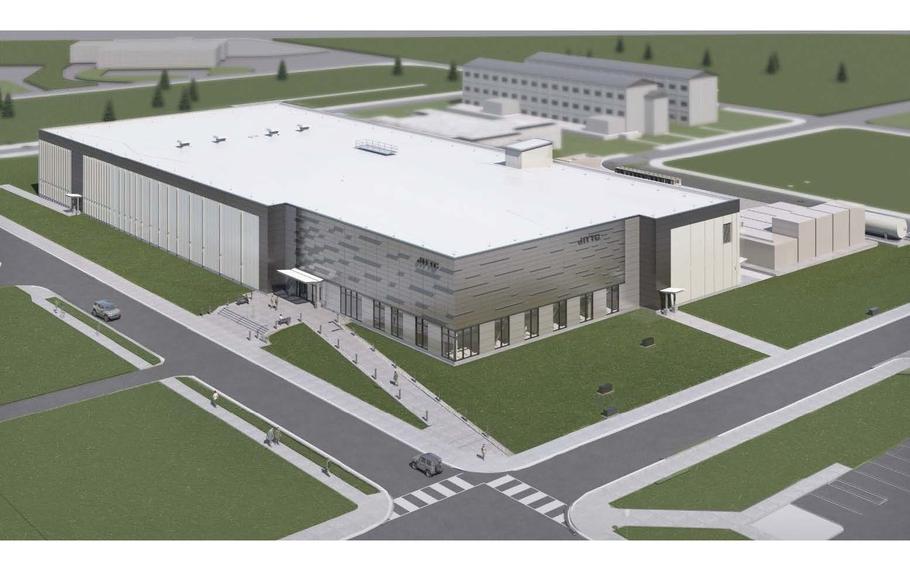
A designer’s concept of Operations Room at future Joint Integrated Test and Training Center to be at Joint Base Elmendorf-Richardson in Alaska. (U.S. Army Corps of Engineers)
Work will start this summer on a Pentagon “mega-project” in Alaska intended to boost the Air Force’s training capability to defend North America.
The 150,000-square-foot Joint Integrated Test and Training Center will contain 426 computer servers kept running by a 15 million megavolt-ampere electric substation. The project is slated to be completed in 2029 at a cost of up to $500 million.
John Budnik, spokesman for the U.S. Army Corps of Engineers, said the center will allow trainers to sync personnel on the ground with pilots in the air.
“It’s the only place in the Indo-Pacific Command that can host multi-domain simulators for joint and coalition fighters, including F-35s, F-22s, F-15s, F-18s, next-generation fighters, bombers, command and control platforms, intelligence surveillance, reconnaissance aircraft, and long-range weapons fire,” he said.
Thareth Casey, the program manager for the Army Corps of Engineers, said the training center is being designed so simulations can be adapted to include weapons and aircraft from other U.S. military branches, as well as NATO allies Canada, Finland, Sweden and others.

A designer's concept of the Joint Integrated Test and Training Center to be built at Joint Base Elmendorf-Richardson in Alaska. (U.S. Army Corps of Engineers)
Air Force Col. Lisa Mabbutt, commander of the 673d Air Base Wing at Joint Base Elmendorf-Richardson, said the training center’s location underlines the importance of Alaska and the Arctic to the U.S.
“It demonstrates a commitment to Alaska as both a key power-projection platform and one of our nation’s leading edges of homeland defense,” Mabbutt said.
While the long, warmer days of summer have allowed military and commercial ships to take advantage of new sea lanes, the training center has to be built to withstand the seasonal flipside: winter, with its minus-20 temperatures and days where sunset comes a little over five hours after sunrise.
Casey, the project manager, said construction less than 2,000 miles from the North Pole has its challenges.
To keep the elements outside from impacting the work inside, the center will be built with a reinforced concrete foundation, steel-frame-insulated wall panels covered in masonry, and a steel-reinforced metal roof.
Construction will accelerate during the long, warmer summer days when the sun can be out for 20 hours. It will slow down during the cold, dark winters.
“It’s a one-of-a-kind project,” Casey said. “We’re constrained by the seasons but with planning, we expect to complete work by the fall of 2029.”
Despite a steady stream of reports about Russian and Chinese joint sea and air operations in the region, the U.S. commands that will be the primary users of the training center declined to specify which nations the training will focus on as possible aggressors.
A query to the 11th Air Force in Alaska was passed to Air Force headquarters at the Pentagon, which passed it to U.S. Indo-Pacific Command in Hawaii — which then passed it back to the 11th Air Force.
But political and military officials have made it clear in earlier statements that the focus will be on training to react to potential threats from Russia and China.
Former Defense Secretary Lloyd Austin and top officers such as Air Force Gen. Anthony J. Cotton, head of Strategic Command, helped popularize the term “near-peer adversary,” a nation with a large military force approaching — it not reaching — equivalence with the United States. The term was most frequently shorthand for Russia. Cotton said in 2023 that Russia, which has about 5,900 nuclear warheads, was a “near peer adversary.”
The other term often used is “pacing challenge” — a country that is building up its military at a rapid rate. A 2023 Pentagon statement said the planned training center at Elmendorf-Richardson would allow “our warfighters to train against our pacing challenge in realistic threat scenarios.”
“China is the only country that can pose a systemic challenge to the United States in the sense of challenging us, economically, technologically, politically and militarily,” Colin Kahl, the Assistant Secretary of Defense for Policy, said in 2023.
Kahl said being a pacing challenge didn’t mean the U.S. had to go to war with China.
“It does mean that we will have a more competitive and, at times, … adversarial relationship with Beijing,” he said.
Russia’s northern border is adjacent to the Arctic Ocean. From czars to Stalin to Putin, it has operated in the region for centuries.
China is a relative newcomer. Though 900 miles from the Arctic Circle, China in 2018 officially declared itself an “near-Arctic state” intent on becoming a “great polar power” by 2030.
In October 2024, a U.S. Coast Guard HC-130J long-range surveillance plane spotted Russian and Chinese ships operating together near the Bering Strait, the sea passage between Alaska and Russia that is just 55 miles wide at its closest point. Last year, American and Canadian fighters were scrambled to intercept Russian and Chinese long-range reconnaissance aircraft flying near the Alaska Air Defense Identification Zone (ADIZ), a U.S.-designated 150-mile buffer zone from U.S. territory.
Katherine Dahlstrand, a fellow at the Center for Strategic and Budgetary Assessments, a Washington, D.C., think tank, said Russia and China see the same military and commercial opportunities as the United States and its allies.
“The Arctic is a new transit space for military assets,” Dahlstrand said. “The potential for shorter trade routes around the world using northern passages would be revolutionary for many countries,” she said. “It draws a lot of interest. The area also has energy resources, fishing, and mining.”
Dahlstrand said putting the training center in Alaska and practicing scenarios for defending the region is an investment that will pay off in the future.
“The Arctic spans the globe and is a connector of regions — European, Indo-Pacific, and North America,” Dahlstrand said. “For the United States, it’s also homeland security.”